Saving Money on School Lighting Design
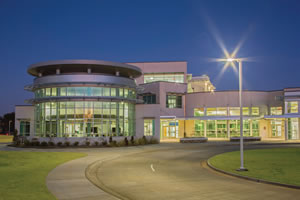
PHOTO COURTESY OF HUBBELL LIGHTING
Today’s schools are loaded with interactive whiteboards,
tablets and flexible furniture, promoting advances in
education, such as blended learning whereby students partly
control the pace of learning. Sadly, however, many schools are also
loaded with outdated, mercury-containing fluorescent lighting,
complete with its humming, flickering, poor color quality, short
lamp life and energy inefficiency.
The lighting movement is toward energy-efficient LEDs, which
are known for lasting 10 years or more, being environmentally safe
and recyclable, providing a more comfortable light for learning
and not containing mercury. So, if you plan on upgrading your
lighting, it only makes sense to upgrade to LEDs.
Another Step Forward
Now, even LEDs have taken a giant step forward and, hopefully,
schools will soon be loaded with tunable LEDs, so forwardthinking
classroom will be evenly matched with forward-thinking
lighting. Comprised of LEDs and flexible controls, tunable white
light creates a more ideal classroom learning environment, in that
it allows the light color temperature to be adjusted to optimal light
levels for specific classroom activities. Warm lighting provides a
relaxing environment for tasks like reading or to calm students
when their energy levels are high. Cooler lighting is well suited for
more intensive academic tasks like test taking.
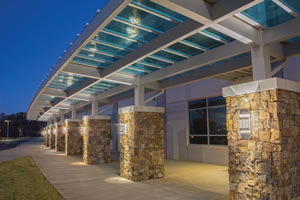
PHOTO COURTESY OF HUBBELL LIGHTING
Acuity’s BLT Series Tunable White Luminaire system, manufactured
by Lithonia Lighting, is one example; there are many on
the market from which to choose. With simple controls, the system
allows teachers to create scenes by controlling the intensity of
lights as well as dimming in selected zones. For example, teachers
can dim the lights at the front of the room when the class is using
a whiteboard or A/V screen. The controllability of the lighting
system is like having four or more different classrooms.
To achieve these dimming effects, classrooms are equipped with
Acuity’s nLight control system, which delivers both dimming and
color tuning effects that teachers can operate at the touch of a button.
The system is equipped with the WallPod Scene Controller, which
provides four scene controls with on/off and dimming settings.
Control pad presets of the classroom system include:
Reading – warm white light at 3000K, for relaxation and focus
Testing – cool neutral white, effective for concentration
General – cooler neutral white light for discussion and collaboration
Energy – coolest at 5000K, similar to daylight, refreshing light for
heightened engagement and to combat afternoon fatigue
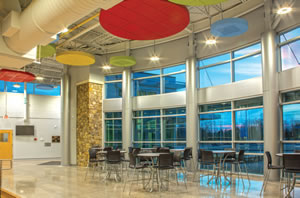
PHOTO COURTESY OF HUBBELL LIGHTING
The preset control pad scenes include:
Scene 1 – all lights on
Scene 2 – lights nearest teaching wall are off for smartboard use,
others dimmed for presentation
Scene 3 – lights nearest teaching wall on 100 percent, others
dimmed for presentation
Scene 4 – all lights dimmed down
Dale B. Davis Elementary School, for Example
Now, thanks to a research partnership with Acuity Brands in
which the system was installed in their school, administrators at
Dale B. Davis Elementary School (Carrollton-Farmers Branch ISD)
in Carrollton, Texas, are addressing both energy management and
classroom learning goals at the same time.
Jenna Jones, fifth grade math and science teacher at Davis
Elementary, offers her experience as to how the system is working. She has a windowless classroom in which she instructs 25 students
per class. Tunable white lighting allows her to “tune” the color of the
light to be just right for their activities. She can change the lighting
scene in her room at the touch of a button, which she does four to six
times each day, which helps the students focus on the task at hand.
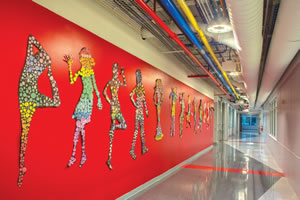
PHOTO COURTESY OF HUBBELL LIGHTING
“In the morning, the first class is extremely quiet,” Jones says. “The
lighting really helps wake us up. Then, when the children come in from
recess all riled up, we change the scene, and it helps bring down our
emotions before we go into a lesson. We change the lighting quite a bit.”
Jones notes more than an effect on behavior: “It’s how they
feel,” she says. “They feel more in control. If they feel in control,
they will focus more and get it done. That’s when they’re going to
be really successful.”
“Energy management is important, but it’s not the number-one
priority by any means,” sums Victor Melton, energy manager for
the school district. “The focus of everything we do is improving
the classroom learning environment. Tunable LED lighting helps
us reach our goal.”
Cheshire Public Schools, for Example
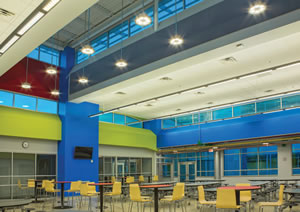
PHOTO COURTESY OF HUBBELL LIGHTING
Administrators at Cheshire Public Schools in Connecticut also
recently turned to tunable LED lighting and, as a result, are saving
$125,000 (82 percent) annually in lighting energy costs. They installed
Mustone LED Illuminations featuring Sunnyvale, Californiabased
Enlighted’s Smart Sensors in all seven of their schools, and it
provides task tuning, occupancy sensing, daylight harvesting and
utility grade metering to verify energy use. It configures and manages
lighting behavior by adjusting software profiles while retaining lighting
data up to 36 months. The system also generates reports on lamp
and fixture outages, carbon reduction, energy and financial savings.
With the Enlighted system in place, Cheshire administrators
have the opportunity to tap into more than lighting savings; they
can tap into additional Internet of Things (IoT) technologies,
including monitoring and controlling building temperatures,
monitoring space utilization, tracking equipment and people, and
smart surveillance and emergency response.
“While Cheshire is reaping the benefits of controlled LED lighting,
it has unlocked the opportunity to better manage all its schools with
the IoT,” says Mike Xenakis, Enlighted’s vice president of Education
Sales. “IoT allows us to support the development of the next generation
of schools — brilliant schools — offering energy efficiency,
HVAC management, space utilization, micropersonalization and security. This leads to a truly enhanced environment
for the students, faculty and staff.”
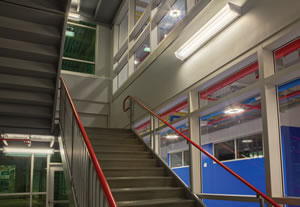
PHOTO COURTESY OF HUBBELL LIGHTING
Schools are made more intelligent by
installing a network of smart sensors that
gather data on things like light, heat, occupancy,
security and asset location. This
data is shared anonymously to a central
repository, so that a suite of proprietary apps
can harvest it for insights and interface with
building systems to optimize the building
environment in real-time. The system and
apps make schools significantly more efficient,
productive, comfortable and secure.
Saving Money
So there isn’t money in the budget for
tunable lighting or IoT, you say. That’s
okay. There may be other things you can do
to save on lighting expenses, which can account
for more than 30 percent of the total
electrical energy consumed. Here’s what
the experts want you to know.
1. It’s about LED. “Presuming a lighting
upgrade in an existing school,” says Bill
Foley, vice president of Brand Management
at Durham, North Carolina-based
Cree, “first and foremost, choose an
energy-efficient source, which LED is. It’s
the cream of the crop and state of the art
in terms of energy savings capability.”
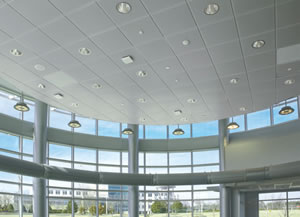
PHOTO COURTESY OF HUBBELL LIGHTING
Focus on Lighting. It is not difficult to understand that different areas of
a facility will require different lighting solutions. The Fisher Middle School
Café, in Greenville, S.C., uses a unique system of two versions of LED lighting,
while architects made other, appropriate choices for the stairwell and
media room. The choices are made based on issues like safety, comfort and
energy efficiency.
2. It’s about communicating. “Cost
savings starts with the superintendent
interacting with the school board to get
the message across that a lighting investment
is going to last 50 years,” says Terry
Clark, founder and chairman of Union
City, California-based Finelite.
3. Lighting is affordable. “Reducing
expenses related to lighting has become
a much more simplified and effective
process,” says Tom Veltri, product
manager of New Product Innovation
for Greenville, South Carolina-based
Hubbell Lighting. “Between state codes,
rebate programs and available design resources
from both manufacturers as well
as channel partners, administrators are
relieved the burden of specifying their
exact needs but rather identify their
financial and operational goals.”
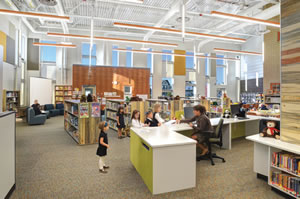
PHOTO BY TIME FRAME IMAGES, COURTESY OF FINELITE
DSST Conservatory Green School designed by RB+B Architects with lighting design by RB+B Architects and M. E. Group.
4. Consider life cycle costs. “We’re all
guilty as consumers of perhaps giving
an improper weighting to a system’s
first cost,” says Foley. “It’s important to
consider a system’s full life cycle cost.
LED is more competitive and lower cost
than when it emerged in the mid-2000s.
So there’s less of a financial hurdle to
overcome. But the quality of light and
solutions vary greatly between manufacturers.
Run the numbers, and consider a
bit higher cost on the front end.”
5. Do It Once; Do It Right. Veltri advises
that administrators wait until they can
afford LED lighting with all the bells
and whistles. “Include tunable white
light, giving teachers the ability to adjust
from 2700K to 6500K,” he says. “Include
plug-and-play controls. If you install
long-lasting lights and give teachers the
ability to make adjustments but they have
to go through convoluted steps to get there,
they’ll be frustrated, and you won’t get better
learning outcomes. If you can’t do all
three at once, then wait until you can, as no
one has been able to come up with meaningful
half steps at this point in time.”
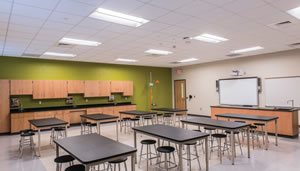
PHOTO COURTESY OF CREE, INC.
6. Sometimes simpler is better. “Identify
what is functionally needed in the space,”
says Veltri. “Most times facility owners
are pushed toward complex lighting
systems and controls when a simpler
retrofit is sufficient. Additionally, controls
may not be advantageous in every region
because of lower energy rates, lack of
legislation or non-existent rebates.”
This article originally appeared in the issue of .